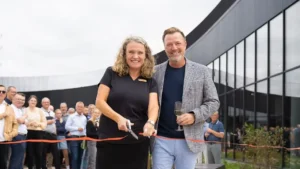For investorerne er det store spørgsmål: Hvem kommer først med en corona-vaccine? Men der er ingen corona-vaccine lige om hjørnet, mener biotech-analytikerne og investeringscheferne hos Morgan Stanley. De forklarer den lange proces for udviklingen af en vaccine – og det viser den udfordring, investorerne står over for. Tidligst i midten af næste år kan man vente en vaccine, der kan nå ud til mange mennesker. Der skal formentlig være flere producenter for at dække behovet, og måske kan der ikke udvikles en effektiv vaccine. Det følgende er en samtale mellem to analytikere fra Morgan Stanley.
The race to a vaccine
Large cap biotech analyst Matthew Harrison talks with Chief Cross-Asset Strategist Andrew Sheets to discuss the latest timeline for a coronavirus vaccine, hurdles to success and possible market reactions.
Current Episode Transcript
Hello, and thanks for joining this special edition of Thoughts on the Market. From London, I’m Andrew Sheets, chief cross asset strategist for Morgan Stanley.
Matthew Harrison: And from New York, I’m Matthew Harrison, managing director and equity research analyst covering biotechnology.
Sheets: Today, we’ll be talking about the road to a corona virus vaccine and how those efforts could help shape the market outlook over the next year. It’s Thursday, June 4th at 2pm in London.
Sheets: Matt, I think a good place to start, Could you talk about some of the different approaches to a vaccine that are being taken and how you’re thinking about that?
Harrison: Sure. So there are a wide variety of approaches to make vaccines. Some are very new technologies, using genetic materials to elicit an immune response. And some are older technologies, where you take the live virus itself and you do what’s called “attenuate it,” or try and reduce the infectiousness of the virus. Those techniques are being broadly used among a wide variety of companies, and there are about 110 approaches that various people have suggested, of which 8 are currently in clinical development.
Sheets: Matt, what’s your timeline for a vaccine? And I guess what are the milestones that you’ll be watching for to know if we are or aren’t making progress on that timeline?
Harrison: Typically with clinical development, there are three phases of study, phase one, phase two and phase three. Typically, they all happen sequentially. And then when you have high confidence that you think you have a real product, typically at the end of phase two, before you start phase three, you ramp your manufacturing so that you’re able to supply your drug to the market.
Here, everything is happening in parallel at the same time. So, what I’m looking for mainly is initial signs of efficacy from phase one studies, I think there’s at least four that I know of that we would expect to see initial data in June. And there we’re looking to see if the vaccine produces a level of “neutralizing antibodies.” These are the antibodies that connect to what’s called the business end of the virus, and that neutralizes the virus.
Harrison: And then the second thing that we’ll be looking for is safety. And so part of that is getting results from animal studies. Those animal studies have been ongoing since early in the year when people started looking at vaccines, but not a lot of those have been reported yet. And then the Phase three program, which the US has probably talked about, enrolling at least 30,000 patients for each vaccine.
Interim data from those will probably be available by the end of the year and that’s when we’ll have a better idea of safety. I think there’s a possibility, if we have strong safety data, for an emergency use authorization sometime in the fall this year. That could be for health care workers only. But in terms of broadly available with enough vaccine available for a lot of people, we have suggested that would be sometime in the summer of 2021.
Sheets: I actually want to talk to that point about broad availability because I think it’s a really crucial one. I mean, what are the numbers that we’re talking about here? You know, how many potential doses of a vaccine would you need in, say, the United States to really vaccinate the population? And is there any precedent for that being ramped up this quickly?
Harrison: Yes. So there isn’t a significant precedent. Just to give you some idea, here we’re talking about ramping to billion dose run rates by the middle of 2021. And so for the U.S, if you want to assume that we get to the three or four hundred million dose range by the end of 2020, which is something the warp speed project has talked about, I think you have to expect more than one vaccine to be viable. If you’re looking for just a single vaccine, we’re probably looking more into the middle of 2021.
Sheets: So, Matt, one thing I’ve heard come up a lot in my investor conversations is concern that we might never find a vaccine for Covid 19. And these investors refer to difficulties with finding vaccines for other types of coronaviruses. What do you think that they’re referring to and how do you think about those challenges?
Harrison: I guess I would make two points. So the first one is, I think there is a high likelihood that we will have a vaccine for this coronavirus. Now, there may be a debate whether or not that vaccine is fully protective, meaning no one gets infected, or converts from having severe disease to having something like the common cold.
The second thing is, unlike, say, HIV, where it has been extremely difficult to develop a vaccine. Every patient, that I’m aware of, that has been tested, who had Coronavirus, I mean, who had Covid 19 I should say, developed antibodies to that. And so it’s usually a very good sign if most patients are developing an antibody response that tells you that your body can mount a response to the virus, which is good for a vaccine. The concern will just be around mutations and other factors.
The final point I’d just like to address is, why isn’t there a vaccine for many of the other coronaviruses? Mainly, there were vaccines in development for MERS and SARS, but because those outbreaks didn’t have the same size and scope, the financial willingness to invest in them without a potential reward on the other side meant many of them didn’t make it past the preclinical stage.
Sheets: This would seem like a particularly challenging public policy question. It’s obviously a major social, major health issue. You want to develop a vaccine as quickly as possible. And yet kind of what is the best way to incentivize that? If you were talking to a policymaker at the moment, what do you think we’re learning about, you know, incentivizing vaccine production? And what do you think are some things that would work better and less well here?
Harrison: I think what you’re seeing happen is actually the right thing to do. The government is essentially saying we will provide you with the capital to make investments without knowing whether or not your vaccine works. So that by the time you get to the point where you know if it works or not, you have already scaled production, made the process improvements, made the capital investments you need to make to be able to produce a lot of doses.
That dramatically changes the incentives for these companies because now they can push forward without the risk of a major loss if the program doesn’t work.
Sheets: So, Matt, what I’d like to move on next is, is another major question that I think is a bit part and parcel with this market focus on a vaccine– really everybody’s focus on a vaccine– which is that, will we see a second wave of infections for Covid 19? When you think about the potential timing of it, how are you thinking about that? What do you think are potential factors that could drive when the next second wave would happen?
Harrison: There are two key ways this virus spreads. The first one is surfaces. So you cough or you sneeze, you touch a surface, somebody else comes along, touches the same surface, touches their face, gets infected.
The second way is direct respiratory transmission, where you are close to someone, they sneeze on you or you are too close to them, they breathe on you, etc. Both of those factors occur less during the summer. More people are outside. Heat and specifically UV radiation and humidity have an impact on the durability of the virus on surfaces. And so while I would expect to see a rise in cases over the summer as states reopen and more people mix.
The greater likelihood is that when everybody starts to move inside in more contained, closed areas as we enter the winter months, you would see an increase in the spread of the virus. And so I think that’s the most likely time period that we might see a second wave.
Sheets: Interesting. So we might see a modest rise over the summer and then a potentially larger rise in the winter, though not as large as what we saw initially. Have there been important changes to the medical approach that would also mean that those second waves feel differently from what we experienced in February, March, and April?
Harrison: Yes. So it’s my hope that because we have greater experience with contact tracing, more availability of testing, and a greater focus on coronavirus, that will lead towards an earlier finding of new cases. And so when you find the new cases earlier, you can essentially blunt the peak, though I would note historically you tend to see cities that were not most affected be the most affected in second or third waves. So, for example, New York may not be the epicenter the next time around. It may be a different city.
Harrison: Andrew, thanks for those questions. There’s obviously been a lot of macro events here in the U.S.. We’ve had coronavirus, we’ve had recent demonstrations. And yet, despite this, the equity markets appear to be very optimistic. Why do you think the equity markets are so optimistic right now?
Sheets: Yeah, thanks, Matt. So this question comes up a lot in my conversations. And I actually don’t think the disconnect between equity markets and what’s happening is as large as it seems, even as odd is as that statement sounds because, as you mentioned, there are still a lot of uncertainties. But I think you have a few key things going on.
The first is that markets lead the economy. And so because our economists think that April represented the lows in economic activity, it would be, I think, very normal for equity markets, credit markets to be doing better, even though the unemployment remains high, even though production numbers remain weak.
The second thing that I think is going on is, is those very factors that you mentioned, the economic weakness, the political uncertainty. I think they’ve made investors quite cautious. And I think it’s meant that investors are holding more cash than they usually do, they’re less invested than they usually are and because of that, you don’t have the vulnerabilities of the market that you would have if everybody were optimistic.
And so that’s another thing that we’re watching is signs that investors are finally throwing in the towel, are finally capitulating and buying into the market. That would be a more worrying sign because I think that would make the market less resilient. But I don’t think we’ve seen it yet.
Sheets: Matthew, great to have you back on the podcast.
Harrison: Great talking with you, Andrew.
Sheets: And thanks for listening. If you enjoy Thoughts on the Market, please take a moment to rate and review us on the Apple Podcasts App. It helps more people find the show.



